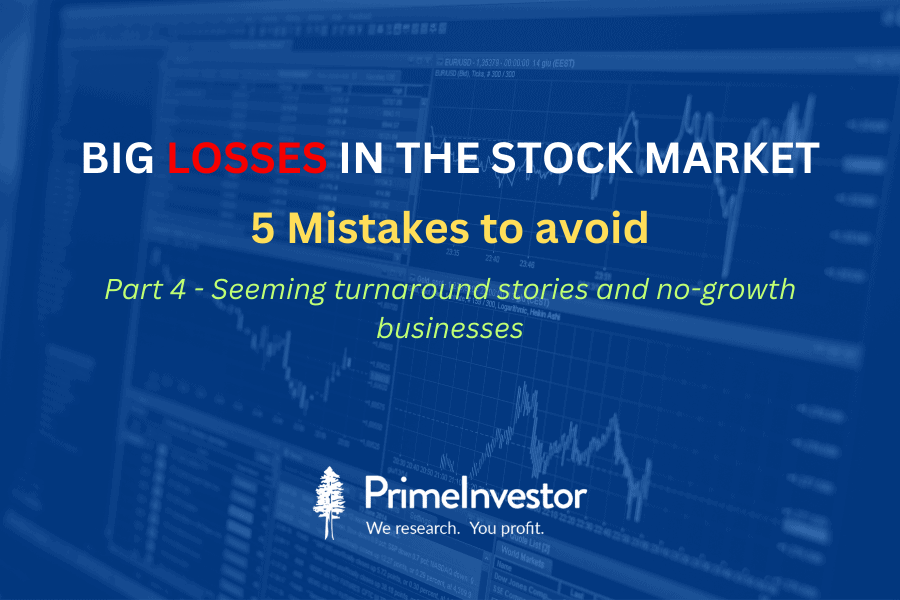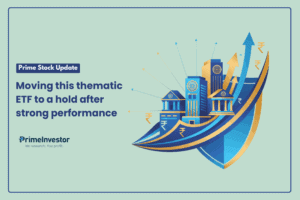This is the fourth part of a 4-part series, where we discuss the five mistakes that lead to big losses in your equity investments and how to avoid them.
The 4-part series is as follows:
- Big losses from rich valuation
- Losses from cyclical businesses
- Losses from low quality businesses
- Losses from seeming turnaround stories and no-growth businesses (this article)

Loss from seeming turnarounds
This is a loss that is entirely linked to how good one’s forecast is, on a company that is at its worst. This trap typically happens when you decide to take bets on very popular stocks that suddenly collapse on any bad news. You do this in the belief that the company should eventually turnaround, given its solid past – especially in the background of the returns that such stocks generated.
When Reliance Power came out with an IPO in 2008 and decided to issue bonus shares later after the stock price plunged, there was again a rush to buy it although it defied the very logic of issuing bonus shares (read our article on corporate actions and what they mean here). Later, a few other infrastructure companies also copied this style to lure investors, only to later leave the investors with penny stocks.
Turnaround or turmoil?
A recent case of a turnaround bet going wrong would be that of DHFL where billionaire investor, the late Rakesh Jhunjhunwala took a bet on this stock when its price collapsed on allegations of dubious loans made to shell companies. But Jhunjhunwala later got out of the stock. But a lot of retail investors held it on turnaround hopes.
DHFL is still alive in Piramal Enterprises. But its equity valuation was written down to ZERO to absorb its business losses.
Same was the case for YES Bank where the NPA write-off and the subsequent re-capitalisation increased its share capital over 12 times. Yes Bank has survived only due to RBI intervention unlike DHFL. But it saw a complete write-off of its old capital and net worth. Any new investor must look at Yes Bank from a fresh perspective in comparison with others. It’s past share price has no relevance.
If you were to take a hypothetical situation of Yes Bank going back to its stock price of Rs.275 before its collapse, that would mean a market cap of Rs.7,70,000 crores on this bloated share capital, even higher than ICICI Bank’s market Cap. Would it have made any sense?
The whole infrastructure pack that boomed in 2007, went down but held hopes of a turnaround. But such hopes were dashed as most of them went to NCLT. These companies did try to save themselves from drowning, but again made the wrong moves. Let’s take some examples. JP Associates divested its profitable cement business to Ultratech and GVK divested its lucrative Airports business to Adani.
While this asset monetisation was happening, investors were still pinning hopes on JP Associates and GVK. But the reality was that they were getting rid of their profitable assets to repay debt and hanging around the troubled ones, a much bigger trap!
On the other hand, GMR smartly retained its airport assets while managing to get rid of its troubled infrastructure and power assets. As pointed out earlier, GMR is the only mid-cap stock at 210th position in AMFI list from infrastructure space. But that was a lucky survivor. If you had bet on this space, odds would not have favoured you!
To sum up:
- betting on turnarounds is like betting on an extremely low probability scenario. This needs both caution and deep pockets if your bet fails.
- The most important thing here is that if a company is doing badly because of business cycle alone and not due to management quality or bad capital allocation decisions and the company is still capable, then that is when it probably merits attention. Even then, its capital structure, debt position, etc. and the business cycle itself matter a lot.
- Getting too early in a turnaround also doesn’t make sense. Improvement in cash flows and debt reduction would be the first two things to look for. If that is not happening, it is better left untouched.
Loss from no-growth businesses
If you have built a portfolio of stocks that provides you with enough income in the form of dividends, you can skip reading this. But in reality, what most of us buy into, when we choose a stock, is the growth story. When that does not transpire, often times, we wish to console ourselves by saying that it is a dividend earner. But there is an opportunity loss here!
In a country where nominal GDP is growing at 11-12%, it makes sense for investors to look for companies that are growing at significantly higher rate than the GDP growth rate (1.25 to 2X) and invest in them. Only this will lead to healthy compounded returns in the long term and build wealth, as equity is expected to.
Given below are a few high-quality companies that have not delivered any returns to shareholders in the last 5 years only because of lack of earnings growth. While there was some growth for VST, its PE multiples witnessed contraction from 23 times to 16 times.
In all these cases, there was losses or almost no returns. When you go for a stock, unless you are looking for dividend earners, do not lose sight of the growth opportunity, even if the stock seems like a good dividend yield. The latter cannot be a substitute for the former!
The securities quoted are for illustration purposes only and are not recommendatory.





2 thoughts on “Big losses in the stock market: 5 mistakes to avoid – Part 4 (Seeming turnaround stories and no-growth businesses)”
A very good set of articles with relevant India specific examples. It was a treat to read through and jog our memories when all these fallen angels were once the darlings of the market.
Thanks primeinvestor Team for this series. It is timely
Comments are closed.